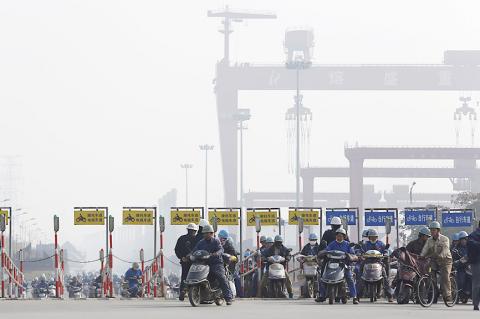China’s exports for last month grew much more strongly than expected, official figures showed yesterday, as a rebound in overseas shipments gained strength on demand from China’s US and Europe.
Exports increased 12.7 percent to US$202.2 billion from November last year, the Chinese General Administration of Customs said — compared with a forecast of 7 percent in a poll of 11 economists by the Wall Street Journal reported by Dow Jones Newswires.
Imports were up 5.3 percent year-on-year to US$168.4 billion, with China’s trade surplus last month expanding to US$33.8 billion from US$31.1 billion in October.

Photo: Reuters
The surplus for last month was also considerably larger than the median forecast of US$21.7 billion by the 11 economists.
The surprisingly strong exports data came after overseas shipments expanded 5.6 percent in October following a decline of 0.3 percent in September.
“China’s November exports came in much higher than expected,” ANZ bank economists Liu Li-Gang (劉利剛) and Zhou Hao (周浩) said in a report, citing “better demand from developed economies” the US and the EU.
The latest trade data came after China’s economy snapped out of a first-half slump, with GDP growth in the third quarter accelerating to 7.8 percent after it slowed during the first two quarters.
Earlier this month, official figures showed that China’s manufacturing growth maintained a strong pace last month from the previous month to stay at a 19-month high.
The purchasing managers’ index (PMI) was at 51.4, unchanged from October, the Chinese National Bureau of Statistics said.
A reading above 50 signals expansion while a figure below indicates contraction.
In the first 11 months of the year, China’s total trade, combining exports and imports, reached US$3.8 trillion, up 7.7 percent from the same period last year, Customs said. The government’s target for this year is 8 percent.
“The data in January to November suggest that China could achieve the 8 percent trade growth target for the whole year,” Liu and Zhou said.
However, they cautioned against overoptimism, stressing what they described as “inflated export growth in the first half of the year” when companies were caught overinvoicing, which instigated a crackdown by Chinese authorities on the practice.
Meanwhile, China, the world’s largest buyer of iron ore, increased imports of the steelmaking ingredient to a record last month as traders replenished stockpiles.
Imports totaled 77.84 million tons last month, up from 67.83 million tonnes in October and 65.78 million tonnes a year earlier, the latest customs data showed.
Cumulative shipments in the first 11 months jumped 10.9 percent to 746.1 million tonnes, the customs agency said.
Iron ore entered a bull market in July as users in China increased stockpiles that shrank in March to the lowest level since 2009.
The market’s supply and demand outlook is positive as producers globally struggle to deliver larger volumes and demand in China continues to grow strongly, Rio Tinto Group iron ore chief executive officer Andrew Harding said on Wednesday.
Additional reporting by Bloomberg

US PROBE: The Information reported that the US Department of Commerce is investigating whether the firm made advanced chips for China’s Huawei Taiwan Semiconductor Manufacturing Co (TSMC, 台積電), the world’s largest contract maker of advanced chips, yesterday said it is a law-abiding company, and is committed to complying with all applicable laws and regulations including export controls. The Hsinchu-based chip giant issued the statement after US news Web site The Information ran a story saying that the US Department of Commerce has launched a probe into TSMC over whether it breached export rules by making smartphone or artificial intelligence (AI) chips for China’s Huawei Technologies Co (華為). “We maintain a robust and comprehensive export system for monitoring and ensuring compliance,” the statement said. “If we

DEMAND FOR AI CHIPS: Net income in the third quarter surged 31.2% quarter-on-quarter to NT$325.26 billion, the strongest quarterly return in the company’s history Taiwan Semiconductor Manufacturing Co (TSMC, 台積電), the world’s biggest contract chipmaker, yesterday raised its revenue forecast to annual growth of 30 percent this year, thanks to strong and sustainable demand for artificial intelligence (AI) processors for servers. It was the second upward adjustment from 25 percent year-on-year growth estimated three months ago, despite recent concerns about whether the AI boom could be another technology bubble. “The demand is real. It’s real. And I believe it is just the beginning of this demand. Alright, so one of my key customers said the demand right now is ‘insane,’” TSMC chairman and chief executive C.C.

Starbucks Corp might have the more recognizable name, but 7-Eleven’s City Cafe remains the king of Taiwan’s fresh coffee market, helped by the convenience store chain’s extensive market presence and product diversification. President Chain Store Corp (PCSC, 統一超商), which runs both the 7-Eleven and Starbucks store chains in Taiwan, established the City Cafe brand in 2004. The brand took off when actress Gwei Lun-mei (桂綸鎂) became its spokesperson in 2007. City Cafe’s sales exceeded NT$10 billion (US$311.69 million) for the first time in 2015, surpassing the revenue of Starbucks Taiwan, and rose to more than NT$17 billion last year, exceeding the NT$14.98

COUNTRY-BASED: Setting ceilings on sales of the technology would tighten limits that originally targeted China’s ambitions in artificial intelligence amid security risks US officials have discussed capping sales of advanced artificial intelligence (AI) chips from Nvidia Corp and other American companies on a country-specific basis, people familiar with the matter said, a move that would limit some nations’ AI capabilities. The new approach would set a ceiling on export licenses for some countries in the interest of national security, according to the people, who described the private discussions on condition of anonymity. Officials in the administration of US President Joe Biden focused on Persian Gulf countries that have a growing appetite for AI data centers and the deep pockets to fund them, the people